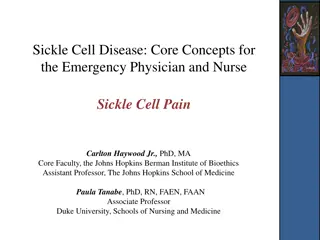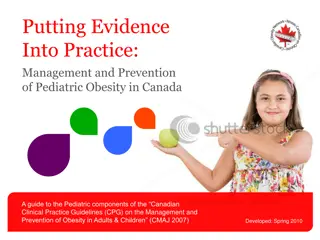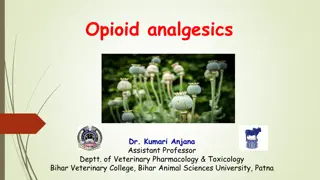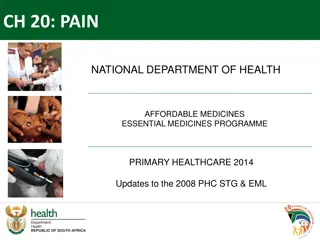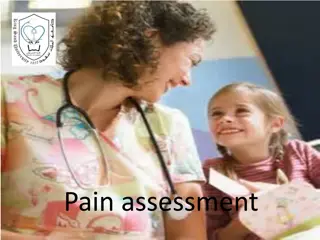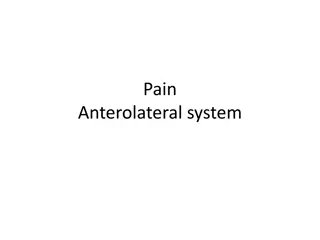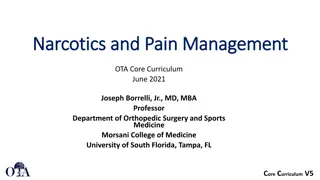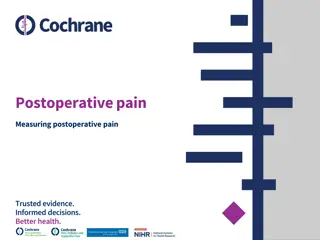Understanding Pediatric Pain Management
Explore the complexities of managing pain in infants and children, including defining pain, classifying different types of pain, understanding pain assessment tools, identifying medication classes for treatment, and recognizing special considerations. Discover insights on acute and chronic pain, neuropathic pain, nociception types, and age-appropriate pain assessment scales like the NIPS for newborns and infants.
Download Presentation

Please find below an Image/Link to download the presentation.
The content on the website is provided AS IS for your information and personal use only. It may not be sold, licensed, or shared on other websites without obtaining consent from the author. Download presentation by click this link. If you encounter any issues during the download, it is possible that the publisher has removed the file from their server.
E N D
Presentation Transcript
Pain Management in Infants and Children Celeste Martin, MD Elisha Peterson, MD FAAP Children s National Hospital
Disclosures No relevant financial relationships
Learning Objectives: Define pain Characterize different types of pain List age appropriate pediatric pain assessment tools Identify classes of medications used for pain treatment Recognize special considerations for pain treatment in children
What is Pain? Pain is An aversive sensory and emotional experience typically caused by, or resembling that caused by, actual or potential tissue injury - International Association for the Study of Pain, proposed new definition 2019
Pain Classification Acute Pain Chronic Pain Purpose: Protective Not protective Related to an anatomical injury Neuronal processing problem Cause: Self limited: resolves with tissue healing Persistent: continues beyond the time frame expected for tissue healing Duration: Medications and conservative management are the mainstay of therapy Multiple modes of therapy (medications, physical therapy, psychological therapy) Treatment:
Types of Nociception commons.wikimedia.org
Types of Pain: Neuropathic Neuropathic pain Damage to nerves Can be peripheral or central Mixed pain combines elements of nociceptive and neuropathic pain
Pain Assessment Pain scales: different scales for different developmental abilities Nonverbal and preverbal children: assess behaviors School age children and adolescents: self-reporting Use scale before and after treatment of pain
Pain Scale: Newborn and Infants NIPS For acute and procedure pain Valid in 25 weeks gestation up to 1 year old Pain Score - 0 - 2: mild - 3 - 4: moderate - 4+: severe
Pain Scale: NIPS Variable Finding Points 0 Relaxed (restful face, neutral expression) Facial Expression 1 Grimace (furrowed brow, chin, jaw) 0 None 1 Whimper Cry* 2 Vigorous 0 Relaxed Breathing pattern 1 Irregular, breath holding, gagging 0 Relaxed (no rigidity) Arms 1 Flexed/extended (tense) 0 Relaxed (no rigidity) Legs 1 Flexed/extended (tense) 0 Sleeping/Awake (peaceful) State of Arousal 1 Fussy (restless, thrashing) 0 Within 10% of baseline Heart Rate 1 11-20% of baseline 2 >20% baseline 0 Supplemental oxygen not needed O2 saturation 1 Additional oxygen required to maintain saturation
Pain Scale: Pre-verbal and Non-verbal Children FLACC scale Face, Leg, Activity, Cry, Consolability For acute and post operative pain Valid in children 2 months to 5 years of age and nonverbal children Pain Score - 0 - 3: mild - 4 - 6: moderate - 7+: severe
Pain Scale: FLACC Scale Score Category 0 1 2 Neutral expression Occasional grimace or frown Very frequent clenched jaw or quivering chin Face Legs Relaxed Restless, tense Kicking or legs drawn up Activity Lying quietly Squirming Arched, rigid, or jerking Crying steadily, screams or sobs Cry None Moans or whimpers Reassured by occasional hugging, distractible Consolability Content, relaxed Difficult to console
Pain Scale: School-aged Children FACES Scale: for children 6-8 years of age Instruct the child by stating : These faces show how much something can hurt. This face [point to the left most face] shows no pain. The faces show more and more pain [point to each from left to right] up to this one [right most face]. It shows a lot of pain. Point to the face that shows how much you hurt now. commons.wikimedia.org
Pain Scale: Adolescents Numeric Rating Scale (NRS) Validated in children 8 years of age and older Rate your pain from 0 being no pain, to 10 being the worst possible pain
Pharmacologic Treatment of Moderate and Severe Pain Consider scheduling pain medications for children who have an active ongoing pain process (such as after surgery) WHO supports a 2 tier approach for pain - Acetaminophen and non- steroidal anti-inflammatory drugs (NSAIDS) for mild to moderate pain - Morphine for moderate to severe pain - Use of codeine and/or tramadol discouraged Severe pain: Opioid scheduled +/- non-opioid +/- adjuvant Moderate Pain: Opioid as needed +/- non opioid +/- adjuvant Mild pain: Non opioid +/- adjuvant World Health Organization (WHO) ladder for pain, designed to address cancer pain
Multimodal Approach NSAIDs Acetaminophen Opioids Non-opioid adjuncts Regional anesthesia
NSAIDs Inhibit cyclo-oxygenase prevents formation of inflammatory mediators that cause pain Act peripherally but may have some central analgesic effects Use caution in infants < 6 months old due to immature renal function commons.wikimedia.org
NSAIDs Proprionic acid derivatives - Naproxen: 5 - 6 mg/kg PO BID - Ibuprofen: 6 - 10 mg/kg PO QID Acetic acid derivatives - Diclofenac: 1 mg/kg tid or 1.5 mg/kg bid - Ketorolac: 0.5 mg/kg (max dose of 30 mg) IV QID; do not use for more than 5 days
Acetaminophen Analgesic and antipyretic that produces analgesic effect by inhibiting prostaglandin synthesis No adverse effect on platelet function or gastric mucosa Metabolized in liver Available PO, PR, IV routes Single dose: 10-15mg/kg/dose up to 1 g every 4 to 6 hours Maximum daily dose: 75 mg/kg/day (or 3750 mg)
Acetaminophen Major side effect is Hepatotoxicity Not usually seen unless significant overdose or high doses used consistently for several days No guidelines to limit length of time used, but caution urged when given continuously for > 10-14 days
Acetaminophen Be cautious when using medications containing opioid-acetaminophen mixtures Percocet (oxycodone-acetaminophen) Vicodin (hydrocodone-acetaminophen) Risk of acetaminophen overdose when acetaminophen alone is used with these opioid-acetaminophen medications
Opioids Derivative of opium/poppy plant Act as a receptor agonist at the level of the spine and the brain Side effects: - Short term: sedation, respiratory depression, delayed GI motility, pruritus, urinary retention - Long term: decrease testosterone production, opioid induced hyperalgesia, tolerance, dependence Continuous pulse oximeter and regular physical exams assessing mentation, oxygenation and ventilation recommended for safety
Opioids: Morphine Potency used as comparison for all other opioids Bolus IV dose 0.05 - 0.2 mg/kg every 2 to 4 hours as needed - Decrease dose in neonates, critically ill, and in patients with obstructive sleep apnea Active metabolites (can accumulate in renal dysfunction) - Morphine-6-glucuronide: analgesia - Morphine-3-glucuronide: no analgesia, agitation, seizures
Opioids: Hydromorphone 5 - 7.5 times more potent than morphine Bolus IV dose* 10 - 20 g/kg every 4 - 6 hours No active metabolites
Opioids: Fentanyl 100 times more potent than morphine Short duration of activity IV Dose: 0.5 - 1 g/kg IV every 30 min to 2 hours No active metabolites
Opioids: Oxycodone Several formulations - immediate-release (IR) - extended release (ER) - combination with acetaminophen (Percocet) Excreted by kidneys and dose must be decreased with renal dysfunction Oral (IR) Dose: 0.1 -0.15 mg/kg every 4 to 6 hours
Opioids: Codeine Pro-drug metabolized to morphine by cytochrome p450 system Ultra rapid metabolizers have increased morphine levels risk of overdose Under metabolizers have decreased morphine levels lack of analgesia
Opioids: Codeine FDA Black Box warnings: Codeine should not be used for: Postoperative pain management in children following tonsillectomy and/or adenoidectomy Treating pain in children younger than 12 years Treating pain in children between 12 and 18 years who are obese or have OSA
Opioids:Tramadol Weak -opioid receptor agonist Serotonin and norepinephrine reuptake inhibitor If given with SSRIs, can potentiate serotonin syndrome; induce seizure Oral Dose: 1 - 2 mg/kg every 6 hours (Max: 400mg daily)
Opioid Conversion Table Opioid IV PO 10 mg 30 mg Morphine Fentanyl 200 mcg - Hydromorphone 1.5 mg 7.5 mg Oxycodone - 15-20 mg
Non-opioid Adjuvants Gabapentin First line for neuropathic pain Binds to voltage-gated calcium channels at the alpha-2-delta subunit and decreases the release of glutamate, norepinephrine, calcium and substance P Oral dose (no IV formulation) must be titrated: - Starting dose 5-7 mg/kg/day - Maximum of 45 mg/kg/day if over 15 kg or 60mg/kg/day if less than 15 kg
Non-opioid Adjuvants Clonidine Nonselective alpha 2 adrenergic agonist - Binds to alpha 1 and alpha 2 receptors - Decreases central norepinephrine release Produces sedation, anxiolysis and analgesia Oral absorption is slow; peak concentrations reached in an hour Oral dose of 4 g/kg preoperatively reduces analgesic use after surgery
Non-opioid Adjuvants Ketamine N-methyl-D-aspartate (NMDA) receptor antagonist - Inhibits release of glutamate, an excitatory amino acid, from the central nervous system - Responsible for analgesia Facilitates analgesia in patients with chronic pain or chronic opioid use IV Infusion dose for analgesia: 0.1 - 0.2 mg/kg/hour Side effects: confusion, dysphoria, hallucinations, tachycardia and hypertension
Local Anesthetics Block voltage gated sodium channels - Anti-inflammatory - Increase tissue oxygenation - Decrease opioid consumption Protein bound, weak bases - Patients less than 6 months of age are at risk of overdose - Do not function in acidic environments (abscess) B=nonionized Local Anesthetic BH=ionized local anesthetic commons.wikimedia.org
Regional Anesthesia Epidural Commonly used for postoperative abdominal or thoracic pain Common local anesthetics are ropivacaine and bupivacaine Risks are dural puncture, bleeding, infection, urinary retention and nerve injury commons.wikimedia.org
Regional Anesthesia Truncal Blocks Can be used for umbilical hernia repairs and other abdominal surgery Include rectus sheath block, transversus abdominal plane block (TAP) and quadratus lumborum block 0.3% rate of complication when done under ultrasound guidance
Regional Anesthesia Peripheral Nerve Blocks Provides targeted pain control for orthopedic procedures Examples include brachial plexus blocks, femoral and popliteal blocks Complications of interscalene and clavicular nerve blocks include include pneumothorax and phrenic and recurrent laryngeal nerve paralysis
Regional Anesthesia Absolute Contraindications - Lack of patient consent - Skin infection at the site of needle insertion - Nerve blockade would hinder the proposed surgery or desired postoperative neurologic exam Relative Contraindications - Coagulopathy - Neuropathy - Sepsis
Conclusions: Pain in children is often under-recognized and under-treated Assess and reassess for signs and symptoms of pain by using developmentally appropriate pain scales By identifying the type of pain present, can select appropriate treatment (such as gabapentin for neuropathic pain) A multimodal approach to treat pain is ideal
References: Anand KJS and Craig KD. New perspectives on the definition of pain. Pain, 67 (1996) 3-6. 1. 2. Beltramini, A, Milojevic, K, Pateron, D. Pain assessment in newborns, infants, and children. Pediatr Ann. 2017;46(10):387 395. 3. Schechter NL, Berde CB, Yaster M. Pain in infants, children, and adolescents. 2003. 4. WHO Guidelines on the Pharmacological Treatment of Persisting Pain in Children with Medical Illnesses. Geneva: World Health Organization; 2012. 1, CLASSIFICATION OF PAIN IN CHILDREN.Available from: https://www.ncbi.nlm.nih.gov/books/NBK138356/. 5. Scholten, W. WHO Persisting Pediatric Pain Guidelines: A Research Agenda. November 2011. 6. Crellin DJ, Harrison D, Santamaria N, Huque H, Babl FE. The psychometric properties of the FLACC scale used to assess procedural pain. J Pain 2018 Aug; 19(8): 862-872. 7. IASP https://www.iasp-pain.org/Education/Content.aspx?ItemNumber=1519. 8. Cravero JP, Agarwal R, Berde C, et al. The Society for Pediatric Anesthesia recommendations for the use of opioids in children during the perioperative period. Pediatr Anesth. 2019. 9. Barash P et al, editors: Clinical Anesthesia (6th ed), Philadelphia, 2009, Lippincott Williams & Wilkins. 10. Wheatley BM, Nappo KE, et al. Effect of NSAIDs on bone healing rates: a meta-analysis. J Am Acad Orthop Surg. 2019;27(7):e330 e336. 11. Konturek PC, Kania J, Burnat G, Hahn EG, Konturek SJ. Prostaglandins as mediators of COX-2 derived carcinogenesis in gastrointestinal tract. J Physiol Pharmacol. 2005;56 Suppl 5:57 73. 12. Cravero JP, Kaplan RF, Landrigan-Ossar M, Cot CJ. A Practice of Anesthesia for Infants and Children. Sixth Edition. Elsevier Inc; 2019:1109-1128.e7. 13. Kaguelidou F, Le Roux E, Mangiarini L, et al. Non-inferiority double-blind randomised controlled trial comparing gabapentin versus tramadol for the treatment of chronic neuropathic or mixed pain in children and adolescents: the GABA-1 trial-a study protocol. BMJ Open. 2019;9(2):e023296. Published 2019 Feb 20. doi:10.1136/bmjopen-2018- 023296 14. Lambert P, Cyna AM, Knight N, Middleton P. Clonidine premedication for postoperative analgesia in children. Cochrane Database of Systematic Reviews 2014, Issue 1. Art. No.: CD009633. DOI: 10.1002/14651858.CD009633.pub2. 15. Mion G, Villevieille T. Ketamine pharmacology: an update (pharmacodynamics and molecular aspects, recent findings). CNS Neurosci Ther. 2013;19(6):370 380. doi:10.1111/cns.12099 16. Schwenk ES, Viscusi ER, Buvanendran A, et al. Consensus Guidelines on the Use of Intravenous Ketamine Infusions for Acute Pain Management From the American Society of Regional Anesthesia and Pain Medicine, the American Academy of Pain Medicine, and the American Society of Anesthesiologists. Reg Anesth Pain Med. 2018;43(5):456 466. doi:10.1097/AAP.0000000000000806 17. Wilder, RT. Local Anesthetics for the pediatric patient . Pediatric Clin June 2000; 47 (3): 545-558.. 18. Long JB, Birmingham PK, De Oliveira GS Jr, Schaldenbrand KM, Suresh S. Transversus abdominis plane block in children: a multicenter safety analysis of 1994 cases from the PRAN (Pediatric Regional Anesthesia Network) database. Anesth Analg. 2014;119(2):395 399.




